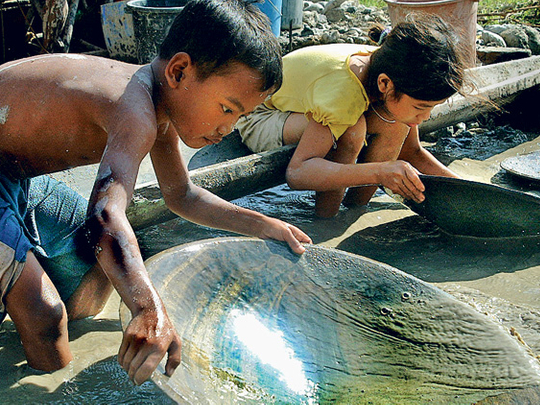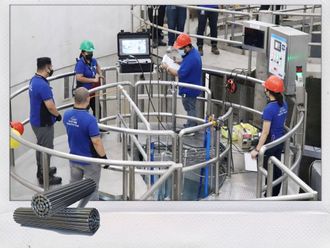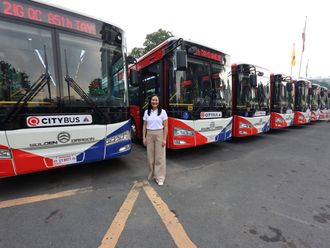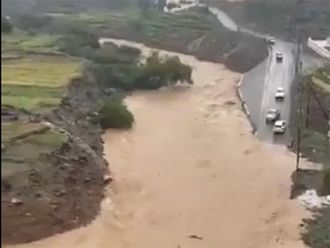
Rodel Moscoso was 10 when he became a small-scale miner in 1994. He hardly saw light every time he descended into a narrow 20-foot tunnel to find precious gold in southern Luzon.
From sunrise to sunset, his eardrums and lungs seemed to burst in the lower depths as he earned less than $1 a day for his poor family in Camarines, Bicol, an International Labour Organisation (ILO) official said during a communications conference in Bangkok last month.
Once, he dunked into a mud-filled tunnel and hauled up dirt for fellow miners to pan for gold. He also fell from a cavern when his father ignited dynamite to crack gold. He thought he was safer when assigned to a nearby riverbed.
But he and his friend panned for gold with bare hands, making them vulnerable to mercury poisoning. They were also exposed to other chemicals as they searched for gold.
In 1998, at 14, Moscoso stopped working and boldly marched against child labour during ILO's awareness campaign in 56 countries. A lady senator put him in school and he graduated with a degree at 25 in 2009. But his inspiring story is an exception to the rule.
Several Filipino children are toiling in 135 small-scale mining sites that cover 4,939 hectares nationwide. Located at the peripheries of big mining operations, many companies are illegal and they violate labour standards with impunity.
In October 2010, authorities found 150 miners aged 14 to 17 who were carrying 50 kilos of ore from a slippery mine tunnel to a loading station in Diwalwal, Compostela Valley, site of a gold rush in the southern Philippines in the 1980s.
They belonged to the Mandaya ethnic group in Kagan Valley, Davao Oriental. They were rescued and a workshop on livelihood projects for their parents was held, said Jalilo dela Torre, the regional labour director.
"Small-scale miners are not mechanised, but they contribute an estimated 25 per cent of the country's total gold production," according to Dr Danilo Israel of the Philippine Institute of Development Studies.
"Small-scale mining is an employment haven for women and children in rural upland areas. It is a lucrative business. Sixteen per cent of its gold production goes to the Central Bank and the rest to the black market," Israel added.
In 2002, the Philippines ranked 29th in gold production. Between 1946 and 2003, total gold production reached 1,172,912 kg, valued at 225 billion pesos ($4.78 million). In 1988, the Philippines was second to South Africa in terms of gold production per unit of land area, the Mines and Geosciences Bureau said.
The state of child labour in the mining industry has remained hazy. In 2001, the National Statistics Office (NSO) said there were only 18,000 small-scale miners in the Philippines.
But 135,000 to 270,000 children have been working as small-scale miners nationwide, said experts whose figures came from earlier studies: Indian professor B.B. Dhar estimated in 1994 that there were 400,000 to 500,000 small-scale miners in the Philippines; R.I. Bayle assessed in 1995 that 250,000 were actual small-scale miners; Dr Israel said in 2002 that 54 per cent of small-scale miners in Aroroy, Masbate, central Philippines and in Tugos, Camarines Norte, southern Luzon, admitted that women and children worked as miners.
Millions of Filipino children are also warriors in government and rebel camps. They are also farmers, deep sea fishermen, domestic helpers and illegally-trafficked sex workers.
They are part of the world's 200 million toiling children who should be studying and enjoying their childhood in schools. In 2001, NSO said that 2.4 million of 4 million young Filipinos were engaged in the worst forms of child labour. The same survey said that 31 per cent of Filipinos were 5- to 17-year-olds.
But in 2007 there were already 9.2 to 10 million child workers in the Philippines, insisted analysts who calculated that 31 per cent or 29.14 million of the country's 94 million population were 5- to 17-year-olds; and that 32.9 per cent of Filipinos lived below the poverty line.
Worse, the number of young workers could skyrocket because of the 2.5 per cent annual growth rate in the Philippines and the rising number of formal employers who employ children to cut costs during the financial crisis.
Surveys should be done more regularly to arrive at the true state of child labour in the Philippines, said the ILO, which will help NSO in a comprehensive data-gathering in 2012. Hopefully, this will help the Philippine government count and rescue child workers, bring them back to school and give poor parents work, critics said.
Dr Rosario del Rosario, social anthropologist at the University of the Philippines, said that total eradication of the worst forms of child labour should be a national concern. "There is still a lack of a clear direction and framework for programmes to fight this problem," she lamented.
In the Philippines, government and school authorities, child workers, their families, and formal employers have accepted child labour as part of poor peoples' lives.
Laws from Congress have partially stemmed the social scourge, but implementation of laws is often left to non-government organisations. Media people have been monitoring in a hurry the signs of social deterioration in their country. Famous and influential personalities have not responded to the raging social issue.
As a result, the Philippine government has predicted that laws passed could only eliminate 75 per cent of worst forms of child labour in 2015, 25 per cent lower than ILO's dream to eradicate the problem in the same year.
The Philippines could easily meet ILO's ideal. The 182 Convention to End the Worst Forms of Child Labour was ratified in 2000 after its release in 1999; the 138 Convention (on) Minimum Wage was ratified in 1988, 25 years after its release in 1973.
But the Philippines is also aiming to win a $1 billion investment in mining. About $630 million was invested in mining in 2008, up from $605 million in 2007.











